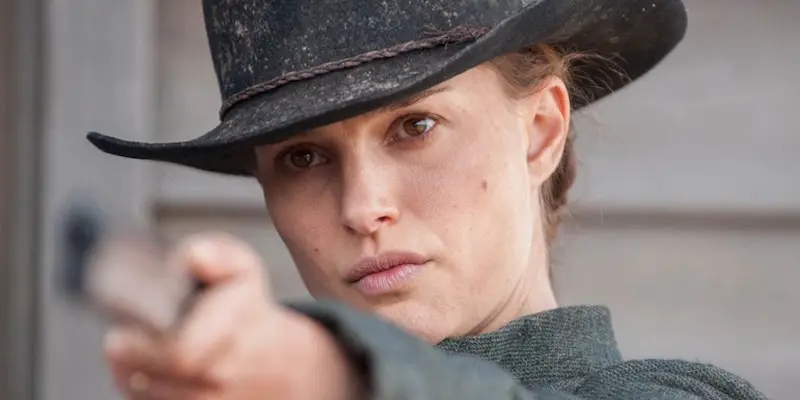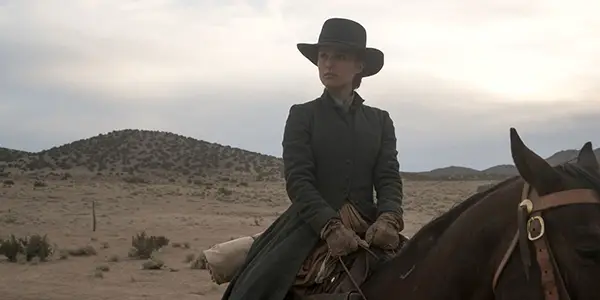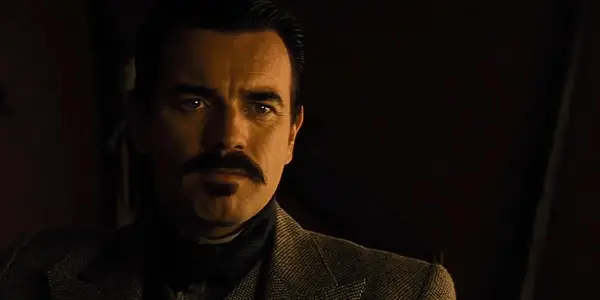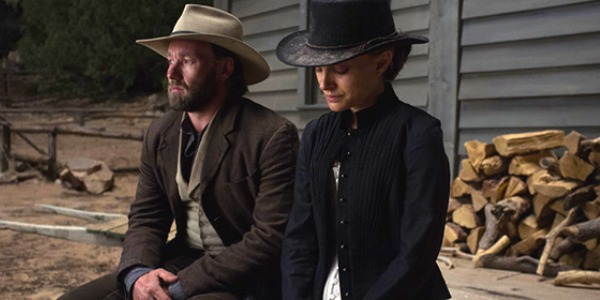JANE GOT A GUN: A Poorly Wrought, Convoluted Mess

David is a film aficionado from Colchester, Connecticut. He enjoys…
Within the last couple of years, the Western seems to have made a semi-comeback. Recent notable titles include John Maclean‘s directorial debut Slow West, the horror-thriller Bone Tomahawk, and Quentin Tarantino‘s claustrophobic and violent The Hateful Eight. And, in just a few months, a remake of The Magnificent Seven will be released, a film adaptation which has attracted the likes of Denzel Washington, Chris Pratt, Vincent D’Onofrio and more (which is hopefully an indication that it is at least halfway decent).
There are always flops amongst the successes, though, an aspect that is unfortunately true of any genre. Jane Got a Gun was perhaps destined for failure from the start, due in part to last-minute script rewrites, production changes, cast dropouts, and more, and over a course of nearly four years. The result is a convoluted and barely watchable mess; a film that will, hopefully, do little to tarnish the careers of those involved.
Unfocused narrative
Jane Got a Gun takes place a decade after the Civil War. Our titular character Jane (Natalie Portman) lives in a lone house in the middle of the midwestern desert with her husband named Bill Hammond (Noah Emmerich) and their daughter. After Bill arrives home with several bullet wounds and the frightened phrase “the Bishops are coming” on his lips, it becomes clear that their past has caught up to them. In flashback, the film proceeds to fill in the gaps, first going back several years to when Jane was engaged to a man named Dan Frost (Joel Edgerton), and slowly leading up to the current day, while also flipping back to the present in-between these sequences, when Jane and Bill now have to face the incoming threat.

If such a premise sounds prone to confusion, you’re not entirely off base. The timeline itself isn’t too difficult to place in chronological order with a little work (also, there are titles on-screen when the film jumps to different points in time), yet the events that take place at each point are seemingly inconsequential when seen individually, to the point where many of them may even be forgotten by the time the film ends.
An example of this confused aspect is the first time jump, which takes place while Jane is in a town buying guns, and she sees a wanted sign that reminds her of the past. The film jumps to seven years prior, when Jane meets both Bill Hammond and John Bishop (Ewan McGregor) for the first time. Yet, after this relatively short scene, the timeline skips to the present once again. Though it’s easy to tell that we have gone forward, the maneuver is still abrupt and unexpected. It’s also extremely jarring to the senses, especially once these time-jumps happen more frequently throughout the film.
Perhaps in an effort to disguise the relatively straightforward narrative of the film, the writers and director Gavin O’Connor just decided to present it in bits and pieces rather than from beginning to end. But in doing so, they ironically make the simplicity of Jane Got a Gun stand out even more.
One-note characters
The all-over-the-place narrative might not have been such an issue if what was evident on screen was at all engaging or interesting. As mentioned earlier, much of this may be due to changes in the production, resulting in not only a flawed and messy script, but last-minute dropouts in the cast.
Two pivotal roles in particular were changed several times at the last minute: that of Dan Frost and John Bishop. Michael Fassbender was originally cast as Frost, but had to drop out due to scheduling conflicts with Days of Future Past. Joel Edgerton, meanwhile, who was originally cast in the role of Bishop, was then given the role of Frost once Fassbender had dropped out. The role of Bishop was then given to Jude Law, who subsequently dropped out due to a change in director; he was replaced by Bradley Cooper, who also had scheduling conflicts, and the role finally went to Ewan McGregor.

While casting changes aren’t anything new in Hollywood, such a drastic back-and-forth of signups and dropouts could only have lended a negativity to the film itself. By the time Joel Edgerton and Ewan McGregor signed on for their respective roles, the producers and director were likely so set on simply making the film that they forgot to bring out the best in their actors. Edgerton and McGregor are obviously talented, with exceptional film roles both in their past and likely upcoming. Here, though, they barely bring any emotional range to their characters. McGregor especially seems to be a miscast, playing his role of the Southern-drawl villain John Bishop without the necessary menace that the role requires.
The film’s only saving grace comes from Natalie Portman, who plays Jane. The attempted modern twist of Jane Got a Gun, which should be evident within the title itself, is that the female protagonist is actually the film’s strongest character. It’s always a positive thing to see elevated roles for women in a genre like a Western, where male protagonists are the standard, and Portman honorably delivers. How unfortunate, then, that the film falls victim to the very same ideals that make some of those male-centered films so outdated. Jane is strong-willed, but far from independent. She is solely reliant on the men around her, to the point where she simply jumps from one to the other throughout the film, depending on what she needs. To witness Portman‘s performance and Jane’s arc from start to finish is both rewarding and upsetting.
A confused blend of classic and modern westerns
The writers of Jane Got a Gun were clearly influenced, at least in part, by classic Westerns. The elements of a classic John Ford flick are all there: the lone gunslinger, the gang of outlaws led by a stone-cold villain, the damsel in distress in need of rescue. Yet, the barely-there quality of each of these makes the film far from the classic Western that it set to homage. The romance between Jane and Dan Frost, for example, could have been reminiscent of a classic like My Darling Clementine or The Man Who Shot Liberty Valance, yet due to some quite ordinary and simplistic cinematography and little chemistry between the two leads, the story falls flat on its face.

Jane Got a Gun is also rated R, and contains the type of violence that would be more fitting in a modern revisionist Western such as Bone Tomahawk or Django Unchained. Far from complementing each other, though, the classic and revisionist western tropes instead clash throughout the film. Scenes of violence are shoehorned in simply as an attempt to show the old West as “harsh” or “gritty,” doing little to propel the film’s narrative in a sensical direction. The final gunfight, for example, is the very definition of anticlimactic.
If done with just the right amount of subtlety, such as in last year’s engaging and original Slow West, the classic and revisionist Western sub-genres could easily have coexisted. What is there, though, is barely enough to fit into either category, and ends up being muddled somewhere between them as a result.
Conclusion
The team behind Jane Got a Gun had a lot of issues at hand even before setting down to film the final production. From in-and-out casting, to changes in director, script, and cinematographer, it’s not too difficult to surmise that the film might have been a mess. Yet, despite its trouble, it’s hard to believe that the film couldn’t have been at least a little closer to something worthwhile. Perhaps if the producers had put the project on hold for a bit longer, and attempted to more properly align the individual pieces of the film; for example, fixing the jump-around narrative, recasting some of the pivotal roles, and taking more time to film the production itself.
Hollywood is a fast-paced environment, though, and a released but poor film is better than no film at all. Though I still have faith in modern Westerns as a whole, I realize that Jane Got a Gun is one of many that will likely be forgotten in time.
What is your favorite modern Western? Do you think the genre has been making a comeback in recent years?
Jane Got A Gun is out on DVD and available on online platforms.
Does content like this matter to you?
Become a Member and support film journalism. Unlock access to all of Film Inquiry`s great articles. Join a community of like-minded readers who are passionate about cinema - get access to our private members Network, give back to independent filmmakers, and more.
David is a film aficionado from Colchester, Connecticut. He enjoys writing, reading, analyzing, and of course, watching movies. His favorite genres are westerns, crime dramas, horror, and sci-fis. He also enjoys binge-watching TV shows on Netflix.












